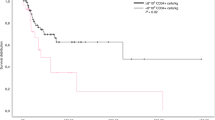Abstract
In order to evaluate the potential clinical and economic benefits of granulocyte colony-stimulating factor (G-CSF, filgrastim) following peripheral blood progenitor cells (PBPC) rescue after high-dose chemotherapy (HDCT), 23 consecutive patients aged less than 60 years with poor-prognosis, high-grade non-Hodgkin's lymphoma (NHL) were entered into a prospective randomized trial between May 1993 and September 1995. Patients were randomized to receive either PBPC alone (n = 12) or PBPC+G-CSF (n = 11) after HDCT with busulphan and cyclophosphamide. G-CSF (300 microg day[-1]) was given from day +5 until recovery of granulocyte count to greater than 1.0 x 10(9) l(-1) for 2 consecutive days. The mean time to achieve a granulocyte count > 0.5 x 10(9) l(-1) was significantly shorter in the G-CSF arm (9.7 vs 13.2 days; P<0.0001) as was the median duration of hospital stay (12 vs 15 days; P = 0.001). In addition the recovery periods (range 9-12 vs 11-17 days to achieve a count of 1.0 x 10(9) l[-1]) and hospital stays (range 11-14 vs 13-22 days) were significantly less variable in patients receiving G-CSF in whom the values clustered around the median. There were no statistically significant differences between the study arms in terms of days of fever, documented episodes of bacteraemia, antimicrobial drug usage and platelet/red cell transfusion requirements. Taking into account the costs of total occupied-bed days, drugs, growth factor usage and haematological support, the mean expenditure per inpatient stay was pound sterling 6500 (range pound sterling 5465-pound sterling 8101) in the G-CSF group compared with pound sterling 8316 (range pound sterling 5953-pound sterling 15,801) in the group not receiving G-CSF, with an observed mean saving of 1816 per patient (or 22% of the total cost) in the G-CSF group. This study suggests that after HDCT and PBPC rescue, the use of G-CSF leads to more rapid haematological recovery periods and is associated with a more predictable and shorter hospital stay. Furthermore, and despite the additional costs for G-CSF, these clinical benefits are not translated into increased health care expenditure.
This is a preview of subscription content, access via your institution
Access options
Subscribe to this journal
Receive 24 print issues and online access
$259.00 per year
only $10.79 per issue
Buy this article
- Purchase on Springer Link
- Instant access to full article PDF
Prices may be subject to local taxes which are calculated during checkout
Similar content being viewed by others
Author information
Authors and Affiliations
Rights and permissions
About this article
Cite this article
Lee, S., Radford, J., Dobson, L. et al. Recombinant human granulocyte colony-stimulating factor (filgrastim) following high-dose chemotherapy and peripheral blood progenitor cell rescue in high-grade non-Hodgkin's lymphoma: clinical benefits at no extra cost. Br J Cancer 77, 1294–1299 (1998). https://doi.org/10.1038/bjc.1998.216
Issue Date:
DOI: https://doi.org/10.1038/bjc.1998.216
This article is cited by
-
Effectiveness of biosimilar pegfilgrastim in patients with multiple myeloma after high-dose melphalan and autologous stem cell transplantation
Annals of Hematology (2023)
-
A comparative effectiveness study of lipegfilgrastim in multiple myeloma patients after high dose melphalan and autologous stem cell transplant
Annals of Hematology (2020)
-
Pegfilgrastim: More Cost Effective and Equally Efficacious Option as Compared to Filgrastim in Autologous Stem Cell Transplant
Indian Journal of Hematology and Blood Transfusion (2019)
-
Early versus late administration of pegfilgrastim after high-dose chemotherapy and autologous hematopoietic stem cell transplantation
Journal of Cancer Research and Clinical Oncology (2012)
-
Retrospective comparison of the effects of filgrastim and pegfilgrastim on the pace of engraftment in auto-SCT patients
Bone Marrow Transplantation (2010)



